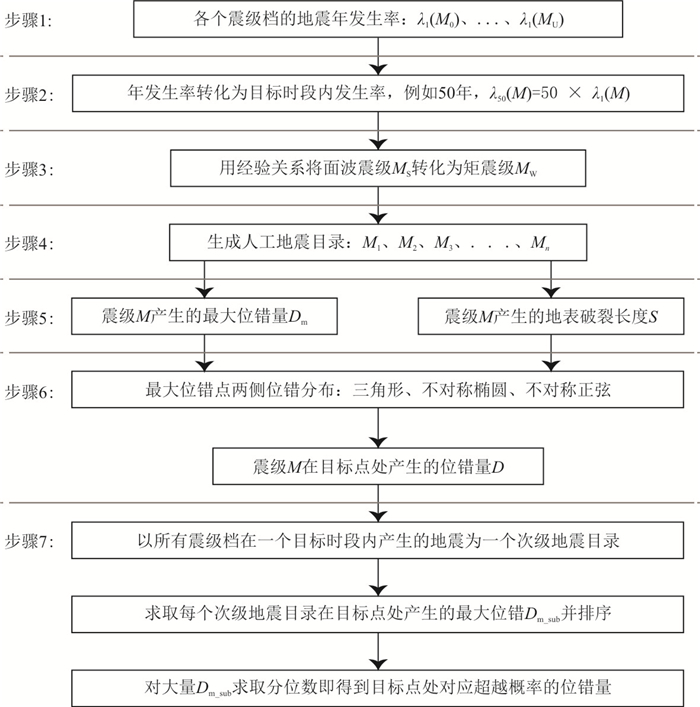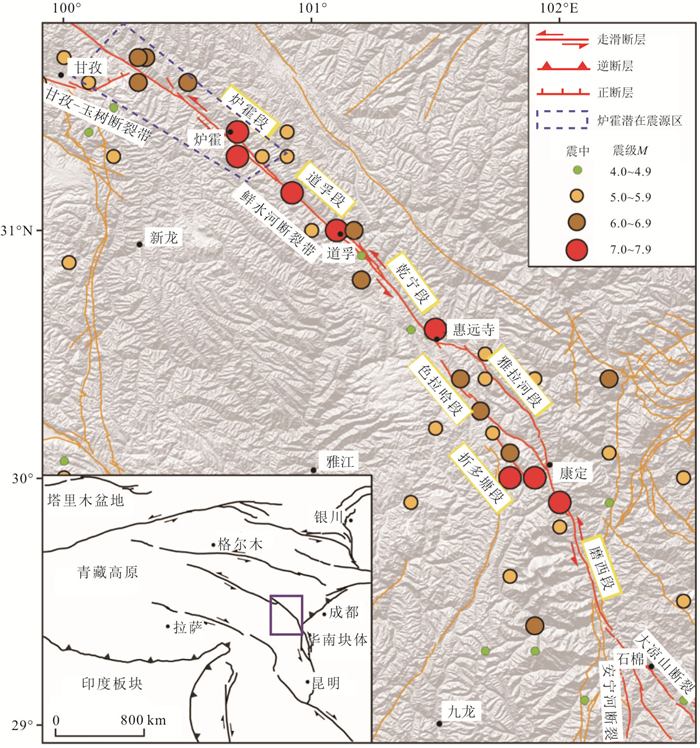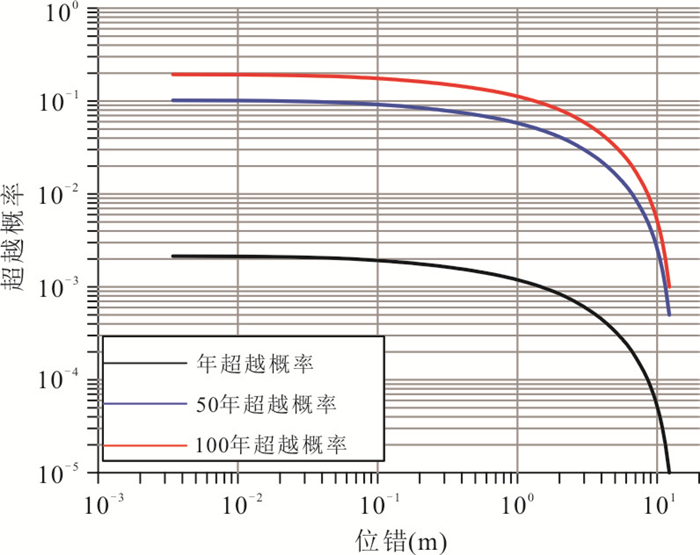Probabilistic Fault Displacement Hazard Analysis Based on Monte Carlo Simulation
-
摘要:
同震位错对川藏铁路等跨断层工程的安全造成严重威胁,合理评价活断层的位错参数具有重要的应用价值.由于传统的确定性评价方法存在无法区分工程场点的重要程度和其在断层上的相对位置等缺陷,越来越多的学者推荐采用概率断层位错危险性分析(PFDHA).然而基于经典的概率性方法开展PFDHA原理复杂且实现困难,不利于吸收断层地震活动性研究的最新成果,也有碍于PFDHA的普及和推广.相比经典的概率性方法,蒙特卡洛模拟具备逻辑清晰易懂、程序易于实现且兼容性和扩展性好的优点.本研究基于蒙特卡洛模拟实现了概率断层位错危险性分析的一般性算法,并将该方法应用于鲜水河断裂带的炉霍段.结果显示,PFDHA的结果随着超越概率水准或工程场点在断层上的相对位置的不同而显著变化.适当考虑最大同震位错和地表破裂长度的不确定性得到的位错参数更加合理.超越概率大于等于100年2%时,PFDHA的结果显著小于确定性方法的结果.然而随着断层活动性的提高,100年超越概率1%的结果可能会大于确定性方法的结果.按照不同类型工程的抗震设防水准选择相应的PFDHA评价结果,既有利于工程的安全,也有助于大多数工程节约成本.PFDHA相比确定性方法具备多种优势,有望为川藏铁路等重大工程的抗断参数评估提供技术支撑.
-
关键词:
- 活动断层 /
- 概率断层位错危险性分析 /
- 蒙特卡洛模拟 /
- 炉霍断裂 /
- 地震学
Abstract:Coseismic displacement poses a serious threat to the safety of cross-fault projects such as the Sichuan-Tibet Railway, and a reasonable evaluation of the displacement parameters of active faults has important application value. Because traditional deterministic evaluation methods cannot distinguish the importance of engineering sites and their relative positions on the fault, more and more scholars recommend the use of probabilistic fault displacement hazard analysis (PFDHA). However, the principle of PFDHA based on classic probabilistic method is complicated and difficult to implement, which is not conducive to application of the latest results of fault seismic activity research, and it also hinders the popularization and promotion of PFDHA. Compared with the classic probabilistic method, Monte Carlo simulation has the advantages of clear and easy-to-understand logic, easy implementation, and good compatibility and scalability. In this study, a general algorithm for probabilistic fault displacement hazard analysis is realized based on Monte Carlo simulation, and the method is applied to the Luhuo section of the Xianshuihe fault zone. The results show that the results of PFDHA vary significantly with the level of exceeding probability or the relative position of engineering site points on the fault. The displacement parameters obtained by properly considering the uncertainty of the maximum displacement and surface rupture length are more reasonable. When the probability of exceedance is greater than or equal to 2% in 100 years, the results of PFDHA are significantly smaller than that of the deterministic method. However, as the fault activity increases, the result of 1% probability of exceeding in 100 years may be larger than that of the deterministic method. Selecting the corresponding PFDHA evaluation results according to the seismic fortification standards of different types of projects is not only beneficial to the safety of the project, but also helps to reduce the costs of most projects. Compared with the deterministic method, PFDHA has many advantages, and is expected to provide reasonable fault displacement parameters for major projects such as the Sichuan-Tibet Railway.
-
图 4 鲜水河断裂的几何展布及其强震分布图(底图改自梁明剑等, 2020)
Fig. 4. The geometry and strong earthquakes distribution of the Xianshuihe fault (revised from Liang et al., 2020)
表 1 炉霍潜在震源区的空间分布函数
Table 1. The spatial distribution function of the potential source area of Luhuo
震级档 M4.0~4.9 M5.0~5.4 M5.5~5.9 M6.0~6.4 M6.5~6.9 M7.0~7.4 M7.5以上 空间分布函数 0.006 64 0.004 86 0.007 55 0.005 10 0.008 34 0.025 81 0.064 07 表 2 炉霍断裂的概率断层位错危险性分析结果
Table 2. The results of probabilistic fault displacement hazard analysis of Luhuo fault
超越概率 目标点
位置(1)考虑不确定性时的位错值(m) (2)不考虑不确定性时的位错值(m) 三角形 正弦 椭圆 均值 三角形 正弦 椭圆 均值 50年2% A 3.522 3 4.485 2 5.191 6 4.399 7 3.763 8 4.726 1 5.434 7 4.641 5 B 2.899 4 3.806 7 4.635 0 3.780 4 3.047 6 4.085 2 4.927 1 4.020 0 C Nan Nan 0.014 0 Nan Nan Nan 0.015 0 Nan 100年2% A 5.378 9 6.750 4 7.562 5 6.563 9 5.612 7 7.227 5 7.568 4 6.802 9 B 4.660 7 5.908 1 6.966 6 5.845 1 4.531 7 5.708 7 7.289 0 5.843 1 C Nan 0.000 1 0.022 6 Nan Nan 0.000 1 0.021 3 Nan 100年1% A 7.091 9 8.779 4 9.643 1 8.504 8 6.915 6 8.436 0 9.639 6 8.330 4 B 6.361 4 7.844 7 8.904 5 7.703 5 6.252 8 7.600 7 8.108 5 7.320 7 C 0.000 1 0.000 2 0.032 4 0.010 9 0.000 1 0.000 1 0.029 8 0.010 0 注:目标点位置A、B和C分别代表断层中点处、断层长度¼处和近断层端点处.Nan表示无有效计算结果,此时3个模型的均值也记为Nan. -
Bayraktar, H. B., Ozer Sozdinler, C., 2020. Probabilistic Tsunami Hazard Analysis for Tuzla Test Site Using Monte Carlo Simulations. Natural Hazards and Earth System Sciences, 20(6): 1741-1764. https://doi.org/10.5194/nhess-20-1741-2020 Ben-Zion, Y., 2008. Collective Behavior of Earthquakes and Faults: Continuum-Discrete Transitions, Progressive Evolutionary Changes, and Different Dynamic Regimes. Reviews of Geophysics, 46(4): RG4006. https://doi.org/10.1029/2008rg000260 Bo, J. S., Huang, J. Y., Zhang, J. Y., et al., 2019. A Prediction Method of Surface Rupture in Strong Earthquakes Based on Logistic Regression Analysis. Earthquake Engineering and Engineering Dynamics, 39(4): 1-7 (in Chinese with English abstract). Chen, R., Petersen, M. D., 2011. Probabilistic Fault Displacement Hazards for the Southern San Andreas Fault Using Scenarios and Empirical Slips. Earthquake Spectra, 27(2): 293-313. https://doi.org/10.1193/1.3574226 Cheng, J., Liu, J., Gan, W. J., et al., 2011. Characteristics of Strong Earthquake Evolution around the Eastern Boundary Faults of the Sichuan-Yunnan Rhombic Block. Science China Earth Sciences, 54(11): 1716-1729. https://doi.org/10.1007/s11430-011-4290-2 Cheng, J., Rong, Y. F., Magistrale, H., et al., 2017. An Mw-Based Historical Earthquake Catalog for Mainland China. Bulletin of the Seismological Society of America, 107(5): 2490-2500. https://doi.org/10.1785/0120170102 Cheng, J., Rong, Y. F., Magistrale, H., et al., 2020. Earthquake Rupture Scaling Relations for Mainland China. Seismological Research Letters, 91(1): 248-261. https://doi.org/10.1785/0220190129 Cheng, J., Chartier, T., Xu, X. W., 2021. Multisegment Rupture Hazard Modeling along the Xianshuihe Fault Zone, Southeastern Tibetan Plateau. Seismological Research Letters, 92(2A): 951-964. https://doi.org/10.1785/0220200117 Cui, H. W., Wan, Y. G., Wang, X. S., et al., 2021. Characteristic of Tectonic Stress Field in Source Region of 2018 Mw7.6 Palu Earthquake and Sulawesi Area. Earth Science, 46(7): 2657-2674 (in Chinese with English abstract). Earthquake Administration of Xinjiang Uygur Autonomous Region, 1985. Fuyun Seismogenic Fault Zone. Seismological Press, Beijing (in Chinese). Hu, Y. X., 1988. Earthquake Engineering. Seismological Press, Beijing (in Chinese). Jin, X., 2019. Study on Prediction Model of Surface Permanent Displacement of Strike-Slip Faults. World Earthquake Engineering, 35(2): 18-23 (in Chinese with English abstract). Liang, M. J., Chen, L. C., Ran, Y. K., et al., 2020. Late-Quaternary Activity of the Yalahe Fault of the Xianshuihe Fault Zone, Eastern Margin of the Tibet Plateau. Seismology and Geology, 42(2): 513-525 (in Chinese with English abstract). Liu, Y. Q., 2013. Study on Surface Permanent Displacement of Active Faults (Dissertation). Institute of Engineering Mechanics, China Earthquake Administration, Harbin (in Chinese with English abstract). Liu, X. W., Wu, Z., Liang, M. J., et al., 2021. Paleoearthquake Characteristics of Jiayuguan Fault and Its Seismic Risk. Earth Science, 46(10): 3796-3806 (in Chinese with English abstract). Ma, S. Y., Xu, C., 2019. Assessment of Co-Seismic Landslide Hazard Using the Newmark Model and Statistical Analyses: A Case Study of the 2013 Lushan, China, Mw6.6 Earthquake. Natural Hazards, 96(1): 389-412. https://doi.org/10.1007/s11069-018-3548-9 Musson, R. M. W., 2000. The Use of Monte Carlo Simulations for Seismic Hazard Assessment in the U.K. Annals of Geophysics, 43(1): 1-9. https://doi.org/10.4401/ag-3617 Nguyen, V. B. Q., Kim, Y. T., 2020. Rainfall-Earthquake-Induced Landslide Hazard Prediction by Monte Carlo Simulation: A Case Study of Mt. Umyeon in Korea. KSCE Journal of Civil Engineering, 24(1): 73-86. https://doi.org/10.1007/s12205-020-0963-8 Pan, H., Gao, M. T., Xie, F. R., 2013. The Earthquake Activity Model and Seismicity Parameters in the New Seismic Hazard Map of China. Technology for Earthquake Disaster Prevention, 8(1): 11-23 (in Chinese with English abstract). Pan, H., Li, J. C., 2006. Study on Uncertainties of Seismicity Parameters b and ν4 in Seismic Statistical Zones. Technology for Earthquake Disaster Prevention, 1(3): 218-224 (in Chinese with English abstract). Petersen, M. D., Dawson, T. E., Chen, R., et al., 2011. Fault Displacement Hazard for Strike-Slip Faults. Bulletin of the Seismological Society of America, 101(2): 805-825. https://doi.org/10.1785/0120100035 Petersen, M. D., Shumway, A. M., Powers, P. M., et al., 2020. The 2018 Update of the US National Seismic Hazard Model: Overview of Model and Implications. Earthquake Spectra, 36(1): 5-41. https://doi.org/10.1177/8755293019878199 Ran, H. L., 2011. Empirical Relations between Earthquake Magnitude and Parameters of Strike-Slip Seismogenic Active Faults Associated with Historical Earthquakes in Western China. Seismology and Geology, 33(3): 577-585 (in Chinese with English abstract). Ran, H. L., Zhou, B. G., 2004a. Probabilitistic Assessment of Potential Ground Offset along Strike-Slip Engineering Active Fault. Journal of Engineering Geology, 12(1): 93-97 (in Chinese with English abstract). Ran, H. L., Zhou, B. G., 2004b. Research on the Probabilistic Assessment of Potential Ground Offset along Active Fault. Seismology and Geology, 26(1): 133-140 (in Chinese with English abstract). Schwartz, D. P., Coppersmith, K. J., 1984. Fault Behavior and Characteristic Earthquakes: Examples from the Wasatch and San Andreas Fault Zones. Journal of Geophysical Research: Solid Earth, 89(B7): 5681-5698. https://doi.org/10.1029/jb089ib07p05681 Stirling, M., Gerstenberger, M., 2018. Applicability of the Gutenberg-Richter Relation for Major Active Faults in New Zealand. Bulletin of the Seismological Society of America, 108(2): 718-728. https://doi.org/10.1785/0120160257 Su, J. Y., Zhou, X. Y., Fan, S. R., 1993. Seismic Hazard Analysis Method for Fault Rupture and Dislocation. Earthquake Engineering and Engineering Vibration, 13(4): 14-21 (in Chinese with English abstract). Sun, J. B., 2002. A GIS-Based System for Probability Evaluation of Potential Surface Displacement on Active Fault Segments Associated with Earthquakes-Theory and Practice (Dissertation). Institute of Geology, China Earthquake Administration, Beijing (in Chinese with English abstract). Valentini, A., Fukushima, Y., Contri, P., et al., 2021. Probabilistic Fault Displacement Hazard Assessment (PFDHA) for Nuclear Installations According to IAEA Safety Standards. Bulletin of the Seismological Society of America, 111(5): 2661-2672. https://doi.org/10.1785/0120210083 Wang, L. P., Zhang, W., Luo, W. W., et al., 2018. Seismic Hazard Analysis Method for Fault Rupture and Dislocation Based on Regional Seismicity Parameters. Journal of Natural Disasters, 27(4): 166-170 (in Chinese with English abstract). Wells, D. L., Coppersmith, K. J., 1994. New Empirical Relationships among Magnitude, Rupture Length, Rupture Width, Rupture Area, and Surface Displacement. Bulletin of the Seismological Society of America, 84(4): 974-1002 Wen, X. Z., Ma, S. L., Xu, X. W., et al., 2008. Historical Pattern and Behavior of Earthquake Ruptures along the Eastern Boundary of the Sichuan-Yunnan Faulted-Block, Southwestern China. Physics of the Earth and Planetary Interiors, 168(1-2): 16-36. https://doi.org/10.1016/j.pepi.2008.04.013 Wesnousky, S. G., 2008. Displacement and Geometrical Characteristics of Earthquake Surface Ruptures: Issues and Implications for Seismic-Hazard Analysis and the Process of Earthquake Rupture. Bulletin of the Seismological Society of America, 98(4): 1609-1632. https://doi.org/10.1785/0120070111 Xu, C., Dai, F. C., Xu, X. W., 2011. Earthquake Triggered Landslide Susceptibility Evaluation Based on GIS Platform and Weight-of-Evidence Modeling. Earth Science, 36(6): 1155-1164 (in Chinese with English abstract). Xu, C., Xu, X. W., Zhou, B. G., et al., 2019. Probability of Coseismic Landslides: A New Generation of earthquake-Triggered Landslide Hazard Model. Journal of Engineering Geology, 27(5): 1122-1130 (in Chinese with English abstract). Xu, X. W., Wen, X. Z., Yu, G. H., et al., 2009. Coseismic Reverse- and Oblique-Slip Surface Faulting Generated by the 2008 Mw 7.9 Wenchuan Earthquake, China. Geology, 37(6): 515-518. https://doi.org/10.1130/g25462a.1 Xu, X. W., Wu, X. Y., Yu, G. H., et al., 2017. Seismo-Geological Signatures for Identifying M≥7.0 Earthquake Risk Areas and Their Premilimary Application in Mainland China. Seismology and Geology, 39(2): 219-275 (in Chinese with English abstract). Xu, X. W., Bai, L. X., Wei, L. M., et al., 2019. Discussion on Initiation Time of the Latest Tectonic Movement in Break-Up Region of the North China Craton. Earth Science, 44(5): 1647-1660 (in Chinese with English abstract). Youngs, R. R., Arabasz, W. J., Anderson, R. E., et al., 2003. A Methodology for Probabilistic Fault Displacement Hazard Analysis (PFDHA). Earthquake Spectra, 19(1): 191-219. https://doi.org/10.1193/1.1542891 Zhao, J. S., Liu, Y. Q., Shi, L. J., et al., 2008. A Probabilistic Approach to Evaluate Permanent Displacement Crossing Fault by 4th Generation Seismic Zoning Map of China. Journal of Earthquake Engineering and Engineering Vibration, 28(4): 22-27 (in Chinese with English abstract). 薄景山, 黄静宜, 张建毅, 等, 2019. 基于逻辑回归分析的强震地表破裂预测方法. 地震工程与工程振动, 39(4): 1-7. https://www.cnki.com.cn/Article/CJFDTOTAL-DGGC201904001.htm 崔华伟, 万永革, 王晓山, 等, 2021. 2018年帕卢Mw7.6地震震源及苏拉威西地区构造应力场特征. 地球科学, 46(7): 2657-2674. doi: 10.3799/dqkx.2020.243 新疆维吾尔自治区地震局, 1985. 富蕴地震断裂带. 北京: 地震出版社. 胡聿贤, 1988. 地震工程学. 北京: 地震出版社. 荆旭, 2019. 走滑型断层地表永久位移预测模型研究. 世界地震工程, 35(2): 18-23. https://www.cnki.com.cn/Article/CJFDTOTAL-SJDC201902003.htm 梁明剑, 陈立春, 冉勇康, 等, 2020. 鲜水河断裂带雅拉河段晚第四纪活动性. 地震地质, 42(2): 513-525. doi: 10.3969/j.issn.0253-4967.2020.02.016 刘艳琼, 2013. 活动断层的地震地表永久位移研究(博士学位论文). 哈尔滨: 中国地震局工程力学研究所. 刘兴旺, 吴赵, 梁明剑, 等, 2021. 嘉峪关断裂古地震活动特征及其强震危险性影响. 地球科学, 46(10): 3796-3806. doi: 10.3799/dqkx.2020.391 潘华, 高孟潭, 谢富仁, 2013. 新版地震区划图地震活动性模型与参数确定. 震灾防御技术, 8(1): 11-23. doi: 10.3969/j.issn.1673-5722.2013.01.002 潘华, 李金臣, 2006. 地震统计区地震活动性参数b值及ν4不确定性研究. 震灾防御技术, 1(3): 218-224. doi: 10.3969/j.issn.1673-5722.2006.03.006 冉洪流, 2011. 中国西部走滑型活动断裂的地震破裂参数与震级的经验关系. 地震地质, 33(3): 577-585. doi: 10.3969/j.issn.0253-4967.2011.03.008 冉洪流, 周本刚, 2004a. 地表潜在断错位移的概率评价方法. 工程地质学报, 12(1): 93-97. https://www.cnki.com.cn/Article/CJFDTOTAL-GCDZ200401016.htm 冉洪流, 周本刚, 2004b. 断层地表潜在突发位移的概率评价初探. 地震地质, 26(1): 133-140. https://www.cnki.com.cn/Article/CJFDTOTAL-DZDZ200401012.htm 苏经宇, 周锡元, 樊水荣, 1993. 断层错动的危险性分析方法. 地震工程与工程振动, 13(4): 14-21. https://www.cnki.com.cn/Article/CJFDTOTAL-DGGC199304002.htm 孙建宝, 2002. 地震活动断层段潜在地表位移概率评价及基于GIS的系统设计(硕士学位论文). 北京: 中国地震局地质研究所. 王丽萍, 张伟, 罗文文, 等, 2018. 基于区域地震活动性参数的断层错动量概率分析方法. 自然灾害学报, 27(4): 166-170. https://www.cnki.com.cn/Article/CJFDTOTAL-ZRZH201804022.htm 许冲, 戴福初, 徐锡伟, 2011. 基于GIS平台与证据权的地震滑坡易发性评价. 地球科学, 36(6): 1155-1164. doi: 10.3799/dqkx.2011.122 许冲, 徐锡伟, 周本刚, 等, 2019. 同震滑坡发生概率研究: 新一代地震滑坡危险性模型. 工程地质学报, 27(5): 1122-1130. https://www.cnki.com.cn/Article/CJFDTOTAL-GCDZ201905024.htm 徐锡伟, 吴熙彦, 于贵华, 等, 2017. 中国大陆高震级地震危险区判定的地震地质学标志及其应用. 地震地质, 39(2): 219-275. doi: 10.3969/j.issn.0253-4967.2017.02.001 徐锡伟, 白鸾曦, 魏雷鸣, 等, 2019. 华北克拉通破坏区最新构造运动起始时间讨论. 地球科学, 44(5): 1647-1660. doi: 10.3799/dqkx.2019.978 赵纪生, 刘艳琼, 师黎静, 等, 2008. 基于第四代地震区划的跨越发震断层永久位移概率分析方法. 地震工程与工程振动, 28(4): 22-27. https://www.cnki.com.cn/Article/CJFDTOTAL-DGGC200804004.htm -










 下载:
下载:






